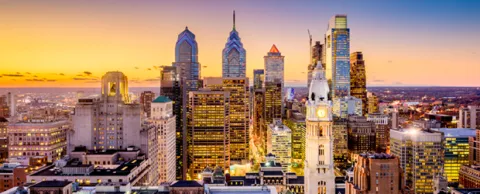
A year ago, we opened the application process for our first Smart Cities Council Readiness Challenge Grants and five cities stood out. Last week, we were in Philadelphia to deliver our final workshop for the Class of 2017 and 200 people participated in the day of inspiration and knowledge sharing.
Cities often look at smart cities initiatives as an expense, albeit a worthwhile one. Philadelphia is looking at them as an economic engine. With an emphasis on equality, it views them as a tool to lift people out of poverty so that one day it won’t have to pay so much treating what it calls “misery.”
It’s an inspiring vision and we look forward to seeing how the city puts the vision into motion. Meanwhile, if you would like to win one of our 2018 Readiness Challenge Grants, the time to act is now! The application process is open and any government jurisdiction in North America is eligible. — Kevin Ebi
Some 25% of Americans don’t have internet access. Philadelphia mayor Jim Kenney says that’s the kind of gap that prevents cities from becoming smart cities.
“Poverty creates the ripple effect of every problem that we deal with,” Kenney told the 200 people in attendance for Philadelphia’s Smart Cities Council Readiness Workshop. “It hits every area of the things we deal with every day. I call it the money we spend on misery.”
But if cities were truly economic engines for everyone, that “misery” money wouldn’t be necessary.
“All of the misery money we spend could be put into education, info infrastructure, into recreation — all of the things we really want a city to be, but a lot of the money gets siphoned off into areas that are directly affected by poverty,” Kenney said.
A call to action for equality
Philadelphia launched its SmartCityPHL initiative a year ago, and Kenney urged those attending the workshop to think first about the disadvantaged when planning any smart cities effort.
“This is the chance, this is the time, this is the moment, that we break down that inequity and we include everybody,” he said. “If we don’t, the jobs that will be created over the next 30-40 years will not be held by people of color, they will not be held by kids who live in our neighborhoods, they will not be held by people who need to get out of poverty. They will continue to be held by the group of people who hold the high-level paying jobs now.
“That’s not what this country should be like.”
Making early progress
The city has been hampered by old systems and infrastructure. It’s now in the process of equipping its police cars with GPS trackers so that dispatchers will be able to know where officers are and see who can respond quickest. Fire calls, however, are still tracked on an antiquated light board and it’s not clear where the funding will come to modernize it.
Workshop participants discussed additional opportunities for improving safety.
One is two-way communication with residents. Today, emergency communication is typically one-way. People call police to ask for help. In a smart city approach, however, police could send alerts to smartphones or digital signage to warn people to stay away from dangerous areas.
A second opportunity involves providing officers a much better way to pinpoint incidents in large areas, like malls and stadiums, where a street address alone is too vague.
In addition to learning about best practices involving data collection and storage, participants learned how cameras with event-monitoring software could revolutionize city decision making on everything from traffic to event planning, including being able to identify which parts of a large festival are more popular than others.
Apply now to win a Smart Cities Council Readiness Challenge Grant for your city.



